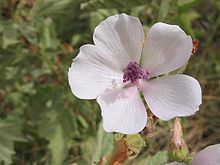Althaea officinalis
| Althaea officinalis | |
|---|---|

| |
| Scientific classification | |
| Kingdom: | Plantae |
| Clade: | Tracheophytes |
| Clade: | Angiosperms |
| Clade: | Eudicots |
| Clade: | Rosids |
| Order: | Malvales |
| Family: | Malvaceae |
| Genus: | Althaea |
| Species: | A. officinalis
|
| Binomial name | |
| Althaea officinalis | |
| Synonyms[1] | |
| |

Althaea officinalis, the marsh mallow
Description
This
The inflorescences occur in the leaf axils and at the top of the stem and consist of panicles of 1-many flowers. The flowers are actinomorphic with 5 lilac/pink petals up to 2 cm long and 5 green sepals which are much shorter than the petals, and fused at the base. Below the petals is a cup-shaped epicalyx with 6-9 narrow, triangular lobes, half the length of the sepals. The purple stamens are united into a tube, the anthers kidney-shaped and one-celled. There is one style which protrudes above the stamen tube.[8] [9]
The flowers are in bloom during August and September, and are followed, as in other species of this order, by the flat, round fruit which are popularly called "cheeses". The whole fruit is a schizocarp, about 1 cm in diameter, which splits into about 20 kidney-shaped mericarps (seeds) about 2 mm long.[8]
The common mallow is frequently called "marsh mallow" in colloquial terms, but the true marsh mallow is distinguished from all the other mallows growing in Great Britain by the numerous divisions of the outer calyx (six to nine cleft), by the hoary down which thickly clothes the stems and foliage, and by the numerous panicles of blush-coloured flowers, paler than the common mallow. The roots are perennial, thick, long and tapering, very tough and pliant, whitish yellow outside, white and fibrous within.
Phytochemicals
Chemical constituents include
Uses
Ornamental
Marshmallows are used in gardening as ornamental plants.
Herbal medicine

The leaves, flowers and the root of A. officinalis (marshmallow) have been used in
Marshmallow is traditionally used as relief for irritation of
Culinary
Most of the mallows have been used as food, and are mentioned by early classic writers with this connection. Mallow was an edible vegetable among the Romans; a dish of marsh mallow was one of their delicacies. Prospero Alpini stated in 1592 that a plant of the mallow kind was eaten by the Egyptians. Many of the poorer inhabitants of Syria subsisted for weeks on herbs, of which marshmallow is one of the most common.[citation needed] When boiled first and fried with onions and butter, the roots are said to form a palatable dish,[16] and in times of scarcity consequent upon the failure of the crops, this plant, which grows there in great abundance, is collected heavily as a foodstuff.
The young leaves can be cooked. The flower buds can be pickled.[17] The roots can be peeled, sliced, boiled and sweetened to make candy. Water used to boil any part of the plant can be used as an egg white substitute.[17]
The root extract (halawa extract) is sometimes used as flavoring in the making of halva. The later French version of the recipe, called pâte de guimauve (or guimauve for short), included an egg white meringue and was often flavored with rose water. Pâte de guimauve more closely resembles contemporary commercially available marshmallows, which no longer contain Althaea officinalis.
Botanical gallery
-
Typically upright and somewhat broad (Austria)
-
Very tall narrow example (?Germany)
-
Typical appearance in flower, closer, showing pale clustered flowers with purple centres (England)
-
Inflorescence, showing pale clustered flowers with purple centres and velvetty, shallow-lobed toothy leaves with recessed veins and (if zoomed) soft-haired stem
-
Flower cluster showing purple anthers and stigmas (Canada)
-
Filaments join into a column, showing purple anthers and (when zoomed) purple pollen spheres (?Germany)
-
Flowers, showing purple anthers when unopened (England)
-
Unopened flower buds from side, showing epicalyces at bud (calyx) bases and velvetty plant stem (England)
-
Unopened flower buds from above, showing tips of epicalyces that are at bud (calyx) base
-
Fruits, showing hairs on smooth fruit surface
-
Fruits, showing a cluster
-
Velvetty leaves (Germany)
-
Leaf, velvetty (here slightly)
References
- ^ a b "Althaea officinalis". Tropicos. Missouri Botanical Garden. Retrieved 2017-04-18.
- ^ "Althaea officinalis". RHS. Retrieved 28 July 2021.
- ^ "Althaea officinalis". Germplasm Resources Information Network. Agricultural Research Service, United States Department of Agriculture.
- ^ ISBN 0-671-73489-X.
- ^ "Marshmallows". NCA. Retrieved 2019-04-20.
- ISBN 978-1-4729-6648-3.
- ISBN 978-0-9560144-0-5.
- ^ ISBN 978-1-5272-2630-2.)
{{cite book}}: CS1 maint: location missing publisher (link - ^ Martin Crawford, How to grow Perennial Vegetables, Green Books, 2012
- S2CID 2114777.
- Perseus Project.
- ^ Harper, Douglas. "marshmallow". Online Etymology Dictionary.
- ISBN 978-1845337315.
- PMID 25311273.
- ^ "John S. Williamson & Christy M. Wyandt 1997. Herbal therapies: The facts and the fiction. Drug topics" (PDF). Archived from the original (PDF) on 2012-04-02. Retrieved 2011-09-16.
- ISBN 0-14-046-440-9
- ^ OCLC 244766414.
Further reading
Cavero, R (December 2, 2014). "Medicinal plants used for respiratory affections in Navarra and their pharmacological validation". Journal of Ethnopharmacology. 158 (Part A): 216–220.












